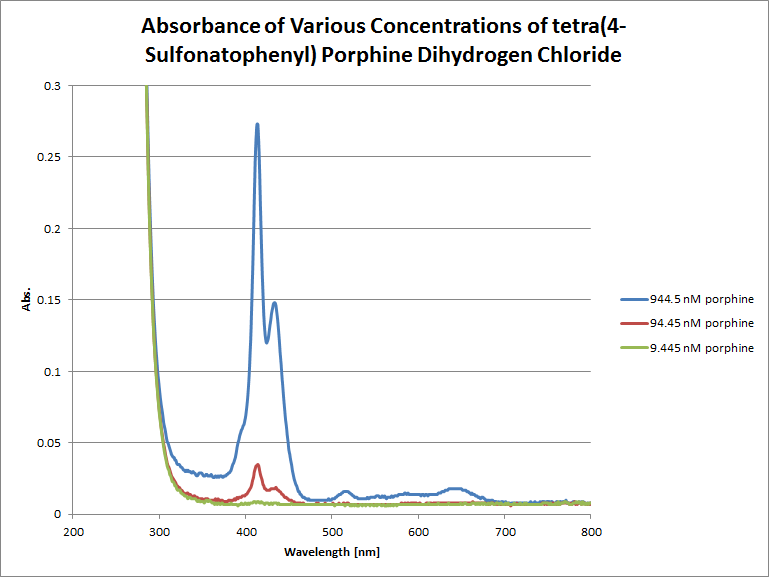OBJECTIVES
- Make PVOH films with NaMT, 50% CEC NaMT, & 100% CEC NaMT for Cu2+ film adsorption
- Measure UV-Vis of all porphyrin solutions (9.445nM – 9.445μM)
- Make PVOH films containing tetra (4-sulfonatophenyl) porphine dihydrogen chloride (PORPHYRIN)
Preparations For Cu2+ Film Exchanged Solutions & Vacuum Filtration Procedures
Follow procedural protocol for Cu2+ Film Exchanged Solutions & Vacuum Filtration Procedures on 10/05/12; however, instead of using clay, use 1g films prepared containing PVOH, glutaldehyde, and clay samples.
UV - Vis Procedures
- Open UV-Vis Pro program on the computer
- Hit the UV-Vis switch at the bottom of the computer setup
- On the bottom of computer screen, click connect button
- Go through UV-Vis Safety Connection Procedures and Protocols for ~ 15 min
- Once finished safety protocol run, click method button
- Select a instrument scanning range (wavelengths = 200 - 800nm)
- Click data window button to create new folder under → CHEM 581 → MKM
- Create name for sample run under new folder MKM
- Prepare a baseline (blank) sample to run in UV-Vis
- Use quartz cuvette specially made for UV-Vis and fill cuvette ¾ full with HPLC grade H2O
- Wipe quartz cuvette gently and thoroughly with a Kim Wipe
- Place cuvette in reference pocket of six sample UV-Vis instrument
- Approve selection and file name then click baseline button
- Run baseline of blank sample (HPLC grade H2O)
- Once finished running, autoscale the y-axis on the screen until max absorption = 1.0
- Save sample name under new folder MKM
Repeat procedure for all UV-Vis Samples run; however, do not have to run a baseline every time after each sample. Baseline only has to be run once throughout the total analysis. Also please be sure to clean each cuvette and wipe thoroughly each time before running new samples for analysis. In addition, place actual samples that are not references in the first pocket of six sample holder in UV-Vis.
UV-Vis of Porphyrin Solutions
- Using a Shimadzu UV-2550 spectrophotometer, spectra of four concentrations of porphyrin solutions were taken:
* Wavelength range = 200 - 800nm
* Slit width = 1.0nm

UV-Vis Analysis Notes
- The baseline was conducted with nothing in the cell.
- For solutions at concentrations 944.5nM and 94.45nM, two peaks were visible at 410nm and 430nm.
- The 9.445nM was not concentrated enough to produce any peaks.
- The 944.5nM solution displayed several more peaks past 500nm, producing more useful data.
Porphyrin Film Preparations
Follow procedural protocol for preparing glutaldehyde films; however, add ~ 1mL of porphyrin in addition to glutaldehyde for each film before pouring substance into a Teflon dish.
| Films Prepared
|
PVOH 22K Amount (g)
|
Glutaldehyde Amount (mL)
|
Porphyrin Amount (mL)
|
| PVOH 22K w/ GA & PP(g) |
1.0073 |
1.0 |
1.0 |
|
| PVOH 22K w/ GA & PP(g) |
1.0067 |
1.0 |
1.0 |
|
| PVOH 22K w/ GA & PP(g) |
1.0523 |
0.5 |
1.0 |
|
| PVOH 22K w/ GA & PP(g) |
1.0211 |
0.5 |
1.0 |
|
|
